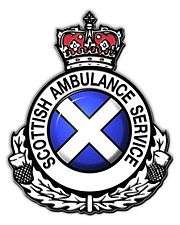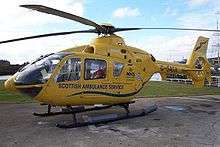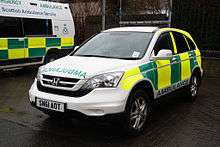Scottish Ambulance Service

The Scottish Ambulance Service (Scottish Gaelic: Seirbheis Charbadan-eiridinn na h-Alba) is the NHS Ambulance Services Trust, part of NHS Scotland, which serves all of Scotland's population. [1]
Uniquely, the Scottish Ambulance Service is considered a special health board and is funded directly by the Health and Social Care Directorates of the Scottish Government. [2]
It is the sole emergency medical service covering Scotland's mainland and islands; providing a paramedic-led accident and emergency service to respond to 999 calls[3], a patient transport service which provides transport to lower-acuity patients[4], and provides for a wide variety of supporting roles including helicopter emergency medical services[5][6], specialist operations including response to HAZCHEM or CBRN incidents[7] and specialist transport and retrieval[8].
History
In 1948, the newly formed National Health Service contracted two voluntary organisations, the St Andrew's Ambulance Association and the British Red Cross, to jointly provide a national ambulance provision for Scotland, known then as the St Andrew's and Red Cross Scottish Ambulance Service. [9]
The British Red Cross withdrew from the service in 1967; the service was renamed the St Andrew's Scottish Ambulance Service. In 1974, with the reorganisation of the National Health Service, ambulance provision in Scotland was taken over by the NHS, with the organisational title being shortened to the now-current Scottish Ambulance Service. [10]
St. Andrew's First Aid, which is the trading name of St. Andrew's Ambulance Association, continues as a voluntary organisation and provides first aid training and provision in a private capacity.[11]
Structure
The Scottish Ambulance Service now continues in it's current form as one of the largest emergency medical providers in the UK, employing more than 4,000 staff in a variety of roles and responding to 740,631 emergency incidents in 2015/2016 alone.[12]
The service, like the rest of the National Health Service is free at point of access and is widely utilised by the public and healthcare professionals alike. Employing almost 1,300 paramedic staff, and a further 1,200 technicians, the accident and emergency service is accessed through the public 999 system.
Ambulance responses are evolving in Scotland and are now prioritised on patient requirement; a traditional, double-crewed ambulance, single response car or a paramedic practitioner may attend emergencies of differing dispositions.
The Scottish Ambulance Service also maintains three command and control centres in Scotland, which facilitate handling of 999 calls and dispatch of ambulances; a further 350-400 staff employed as call handlers and dispatchers fulfil this role[12] across three locations - Edinburgh, Glasgow and Inverness. These three centres (which, through use of software operate as one integrated unit) have been in use since 2004 and handle over 800,000 calls per year. The AMPDS system is used for call prioritisation, and provides post-dispatch instructions to callers allowing for medical advice to be given over the phone, prior to ambulance arrival.[13] Clinical staff are present to provide clinical oversight and tertiary triage. Co-located with the Ambulance Control Centres (or ACC) are patient transport booking and control services, which handle approximately 1 million patient journeys per year. [13]
Vehicles, Equipment & Uniform

The Scottish Ambulance Service maintains a varied fleet of around 1,500 vehicles. [14]
This includes traditional ambulances, which are being replaced in a fleet upgrade project[14] , single-response vehicles such as cars and small vans for paramedic practitioners, patient-transport ambulances which come in the form of adapted minibuses, lorries and support vehicles for major incidents and events, and specialist vehicles such as 4x4s and tracked vehicles for difficult access.[15]
The unique geography of Scotland, which includes urban centres such as Edinburgh and Glasgow, areas of relatively low-population such as Grampian and the Highlands, and the Island communities mean that fleet provision has to be flexible and include different approaches to vehicle construction. In the past, 4x4-build ambulances on van chassis have been used in more rural areas, and traditional van-conversions in more urban.[14]
With a large fleet upgrade project being commissioned in 2016, the business case was made to move to a solely box-body on chassis build, to provide some flexibility and more resilient parts procurement. Most of these replacement ambulances have been based on either Mercedes or Volkswagen chassis, with a mixture of automatic or manual transmissions.[14]
The equipment used on board Scottish Ambulance Service vehicles broadly falls in line with NHS Scotland and allows for intraoperability in most cases. Equipment is standardised nationally and replaced at regular service intervals; for example, high-cost items such as defibrillators are costed and changed every 7 years according to clinical need.[16]
The uniform falls in line with the NHS Scotland National Uniform standard[17], which is in keeping with the uniform standard described by the National Ambulance Uniform Procurement group in 2016. [18] Amongst cost and comfort considerations, all Scottish Ambulance Service Staff now wear the national uniform which comprises a dark green trouser / shirt combination.[19]
Personal Protective Equipment (boots, helmet and protective jackets) are issued to all staff and denote rank / clinical rank by way of epaulette and helmet markings.[19]
Organisation

The national headquarters are in west side of Edinburgh and there are five divisions within the Service, namely:
| Division | Covering | Area in Square Miles | Divisional HQ |
|---|---|---|---|
| North | Highlands, Western Isles, Grampian, Orkney, Shetland[20] | 15,607 | Raigmore Gardens, Inverness, IV2 3UL |
| East Central | Fife, Forth Valley, Tayside[21] | 4,421 | 76 West School Road, Dundee, DD3 8PQ |
| West Central | Greater Glasgow, Lanarkshire[22] | 1,054 | Range Road, Motherwell, ML1 2JE |
| South East | Edinburgh, Lothian and Borders[23] | 2,457 | Kings Haugh, Peffermill Industrial Estate, Edinburgh, EH16 5UY |
| South West | Argyll, Argyll islands, Clyde islands, Ayrshire, Dumfries and Galloway[24] | 6,670 | Maryfield Road, Ayr, KA8 9DF |




Patient Transport
The Patient Transport Service carries almost 1.6 million patients every year. This service is provided to patients who are physically or medically unfit to travel to hospital out-patient appointments by any other means can still make their appointments. The service also handles non-emergency admissions, discharges, transport of palliative care patients and a variety of other specialised roles.
Patient Transport Vehicles come in a variety of forms and are staffed by Ambulance Care Assistants, whom work either double or single crewed. They are trained to look after patients during the journey, and to provide basic emergency care.
Air Ambulance Division
The service has the only government-funded air ambulance service in the UK,[25] operated under contract by Gama Aviation. The fleet consists of two Airbus H145 helicopters[26] (operated under sub-contract by Babcock Mission Critical Services Onshore Ltd.) and two Beechcraft B200C King Air fixed-wing aircraft, which provide emergency response and transfers of patients to and from remote areas of Scotland. In 2015/16, the air ambulance crews flew 3,849 missions. One helicopter and one King Air are based at a Gama Aviation facility at Glasgow Airport. The other operating bases are Inverness Airport (helicopter) and Aberdeen Airport (King Air).[27]
The aircraft based in Glasgow are regularly used by the UK's only Emergency Medical Retrieval Service. The air ambulance service was occasionally featured as part of the popular Channel 5 television documentary series Highland Emergency.
Charity-funded air ambulance
In late 2012 a charity was founded to provide a further air ambulance, based at Perth Airport, to work alongside the state-funded aircraft.[28] Scotland's Charity Air Ambulance (SCAA) commenced operations in May 2013 with a Bolkow 105 airframe. Since November 2015, SCAA operates a Eurocopter EC-135 helicopter.[29] The helicopter is crewed by Scottish Ambulance Service paramedics, tasking is from the SAS ambulance control centre at Cardonald.
Special Operations Response Team (SORT)
In 2010 the service established three teams of specialist accident & emergency ambulance personnel who were given specialist training.[30] This £4.3 million initiative was to provide additional preparedness to be able to respond to large-scale hazardous incidents, such as those that might involve chemical, biological, radiological or nuclear material. The work was in concert with the UK government.
As of 2016 there are five SORT teams, three full-time and two on-call. These teams provide a specialist response to major incidents, and provide paramedic care in hostile environments. The team provides capability in arenas such as water rescue, safe working at height, search and rescue including the use of breathing apparatus, and confined space working. The SORT teams also provide a full-time emergency decontamination and inner-cordon capability. The full-time SORT teams also provide specialist support to police firearms teams, using ballistic protection to provide care to casualties in a live-fire zone.[31]
Scotstar and Emergency Medical Retrieval Services (EMRS)
With the remote towns and villages in Scotland often being hours away from advanced medical treatment, Scotstar (paediatrics) and the Emergency Retrieval Service were set up. The Scotstar service was set up on the 1 April 2014 and transported 2,654 patients 2014/2015. The teams are composed of Paediatricians and PICU nurses. The service has access to multiple vehicles including: Specialist ambulances, 2 air ambulance helicopters and 2 air ambulance planes. The service is based at Glasgow Heliport.
The Emergency Medical Retrieval Service was started in 2004 by 10 Emergency Medical Consultants from Glasgow and Paisley. Providing aeromedical cover to six hospitals within Argyll and Bute. The 10 Emergency Medical Consultants only had £40,000 worth of funding for medical equipment. In its first year the service transported 40 patients. In years to follow the clinical crew began to gather evidence for the lifesaving and cost effectiveness of the service. In 2010 the service was opened up to the whole of the country, thanks to backing by permanent funding. The service became part of Scotstar in 2014. The service is staffed by 27 part time consultants, 2 full time registrars and seven Critical Care Practitioners.
Training Academy
The Service has its own dedicated training academy within the campus of Glasgow Caledonian University, which opened in June 2011.[32] The facility has purpose built classrooms, lecture theatres, syndicate rooms and a clinical simulation area that recreates a 16-bed hospital ward and Accident & Emergency department allowing realistic interaction with other trainee healthcare professionals.[33]
Prior to April 2011, the service used its own dedicated training college located at Barony Castle in Eddleston near Peebles. Set in 25 acres (100,000 m2) of formal gardens and woodlands, Barony was a residential training and conference centre with 78 bedrooms that allowed the service to carry out all its training in house.
Facts and figures
In 2015/16, the service:[34]
- Responded to 736,906 accident and emergency incidents.
- Carried out 894,691 non-emergency patient journeys.
- Flew 3,849 air ambulance missions.
- The average response time to life-threatening (Cat A) calls throughout Scotland was 7.4 minutes.
- The service employs 4,305 staff, of whom 536 are in support services and administration and 16 are board members.
See also
Other Scottish emergency and non-emergency services:
References
- ↑ "Scottish Ambulance Service - The Service". www.scottishambulance.com. Retrieved 2017-08-10.
- ↑ "Collective Assessment of NHS Scotland Special Health Boards". Scottish Ambulance Service.
- ↑ "Scottish Ambulance Service - Emergency response". www.scottishambulance.com. Retrieved 2017-08-10.
- ↑ "Scottish Ambulance Service - Patient Transport Service". www.scottishambulance.com. Retrieved 2017-08-10.
- ↑ "Scottish Ambulance Service - Air Ambulance". www.scottishambulance.com. Retrieved 2017-08-10.
- ↑ "Scottish Ambulance Service". www.associationofairambulances.co.uk. Retrieved 2017-08-12.
- ↑ "Scottish Ambulance Service - Dealing with Major Incidents". www.scottishambulance.com. Retrieved 2017-08-10.
- ↑ "Scottish Ambulance Service - Specialist Transport and Retrieval". www.scottishambulance.com. Retrieved 2017-08-10.
- ↑ "Our History - St Andrews First Aid". St Andrews First Aid. Retrieved 2017-08-10.
- ↑ "Our History - St Andrews First Aid". St Andrews First Aid. Retrieved 2017-08-10.
- ↑ "First Aid Delivered With Confidence - St Andrews First Aid". St Andrews First Aid. Retrieved 2017-08-10.
- 1 2 "SAS Annual Report 2015/2016" (PDF).
- 1 2 "Scottish Ambulance Service - Behind the Headlines - Ambulance Control Centres". www.scottishambulance.com. Retrieved 2017-08-10.
- 1 2 3 4 "Fleet Replacement Business Case 2016/2017" (PDF).
- ↑ "FOI Scottish Ambulance Service Vehicle List".
- ↑ "SAS Corporate Asset Management Strategy".
- ↑ ceu@scotland.gsi.gov.uk, Scottish Government, St. Andrew's House, Regent Road, Edinburgh EH1 3DG Tel:0131 556 8400 (2012-07-03). "NHS National Uniforms". www.gov.scot. Retrieved 2017-08-11.
- ↑ "New national ambulance uniform could save the NHS £3.4m - Emergency Services Times". Emergency Services Times. 2017-01-13. Retrieved 2017-08-11.
- 1 2 "FOI Response - Scottish Ambulance Service Uniform" (PDF).
- ↑ Locations - North scottishambulance.com, accessed 9 May 2009
- ↑ Locations - East Central scottishambulance.com, accessed 11 February 2009
- ↑ Locations - West Central scottishambulance.com, accessed 11 February 2009
- ↑ Locations - South East scottishambulance.com, accessed 11 February 2009
- ↑ Locations - South West scottishambulance.com, accessed 11 February 2009
- ↑ "What we do: Air ambulance". Scottish Ambulance Service. Retrieved 20 December 2014.
- ↑ "'Technical difficulties' put stop to air ambulance's island tour". STV News. 3 July 2015. Retrieved 8 April 2016.
- ↑ "What we do: Aircraft". Scottish Ambulance Service. Retrieved 2 June 2016.
- ↑ "Perth base for Scotland's charity air ambulance". BBC News. 27 November 2012. Retrieved 8 April 2016.
- ↑ "New helicopter unveiled for Scotland's Charity Air Ambulance". STV News. 30 October 2015. Retrieved 8 April 2016.
- ↑ "Ambulance disaster teams created". BBC News. 11 August 2010.
- ↑ "Working for us:Special Operations Response Team". Scottish Ambulance Service. Retrieved 11 April 2016.
- ↑ "Nicola Sturgeon unveils new Scottish Ambulance Academy at Glasgow Caledonian University". Daily Record. 27 June 2011. Retrieved 8 April 2016.
- ↑ "New Academy is a major milestone for Ambulance professional development" (Press release). Scottish Ambulance Service. 8 Feb 2011. Archived from the original on 2 Feb 2012. Retrieved 12 May 2014.
- ↑ "Scottish Ambulance Service Annual report 2015/16" (PDF). Scottish Ambulance Service. Retrieved 2 Nov 2016.
External links
 Media related to Scottish Air Ambulance at Wikimedia Commons
Media related to Scottish Air Ambulance at Wikimedia Commons Media related to Ambulances in Scotland at Wikimedia Commons
Media related to Ambulances in Scotland at Wikimedia Commons- Official website